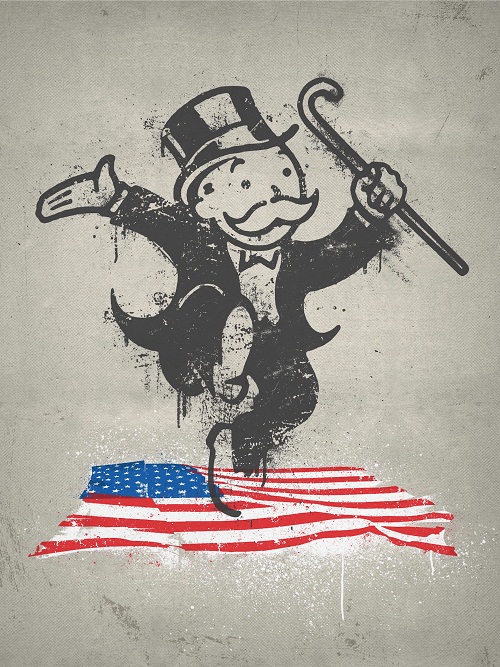
Brad Kayal. "Job Creators,” from “Occuprint 2012.” Color screenprint, 18 x 12 in. Published by Occuprint.org, edition of 100. Image courtesy Booklyn Artists Alliance, Brooklyn.
High political season is underway with a particular sense of urgency this year, and it seems that nearly every aspect of American culture has joined in the debate. In keeping with a historical trend that began during the Enlightenment, prints are playing a role in today’s political arguments as a means of disseminating the views of artists and rallying the people. Recent releases of note are the Occuprint Portfolio 2012 and Artists for Obama 2012. Both are fundraisers to support their eponymous causes: the former was issued earlier this year through the Booklyn Artists Alliance–the latter debuted last night at Gemini G.E.L. in Los Angeles and will also be presented in its New York gallery in Chelsea later this month.
While these two print portfolios are both political in their aims, other similarities are few. The facture and content of Occuprint, as may be anticipated, reflects the values and concerns of the grass-roots Occupy Movement that spawned it. Issued in an edition of 100 with a net fundraising goal of approximately $30,000, the thirty screenprints it contains were selected from the thousands of submissions that have been posted for free download on the Occuprint.org website. Since last fall, these have been sent in by relatively unknown designers from all over the world in support of the various political aims that have sprung from the Occupy Movement, including We are the 99%, the ballooning costs of higher education, the subprime mortgage crisis, as well as May Day. The portfolio’s production was supported by pre-publication sales to twenty public institutions, including a number of top universities, and proceeds benefit the activities of Occuprint.org, a non-profit affinity group that operates independently of the Occupy Movement.

Joe Thompson. "Occupy Homes,” from “Occuprint 2012.” Color screenprint, 18 x 12 in. Published by Occuprint.org, edition of 100. Image courtesy Booklyn Artists Alliance, Brooklyn.
Artists for Obama 2012 represents the other end of this spectrum, intended for high-level collectors and supporters of the President’s re-election campaign, with a fundraising goal of over $4 million. Following on the successful release of a similar portfolio for his 2008 run, Obama’s campaign organizers worked with Gemini G.E.L. in Los Angeles to produce a portfolio of original prints by nineteen celebrated artists, including John Baldessari, Chris Burden, Ann Hamilton, David Hammons, Jasper Johns, Julie Mehretu, Bruce Nauman, Susan Rothenberg, Ed Ruscha, Richard Serra, Richard Tuttle, and others. Each were asked to participate earlier this spring and collaborated with the master printers at Gemini G.E.L. over the past several months to produce original work for the portfolio in a variety of media. Though production of the edition of 150 is still underway, all imagery is now final. The portfolio was unveiled last night at a fundraising event at Gemini’s Los Angeles workshop with a special appearance by Valerie Jarrett, Obama’s senior advisor, and food by a selection of celebrity chefs, including Michael Voltaggio of “Top Chef” fame; several of the artists were also present. Details of the New York fundraiser and portfolio presentation on Monday, September 24 at Gemini G.E.L. at Joni Moisant Weyl in Chelsea are forthcoming, though a number of the artists have confirmed they will be in attendance. The portfolio will remain on view in the gallery through Election Day on Tuesday, November 6.
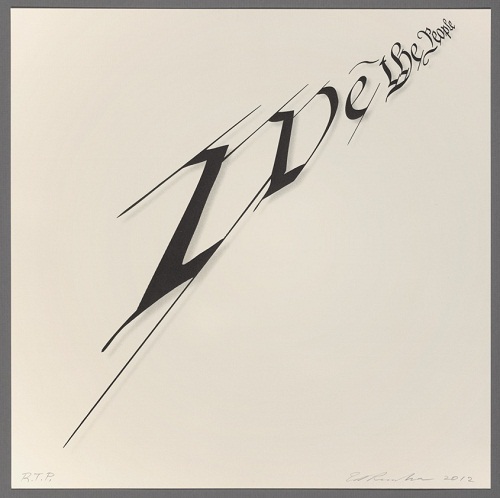
Ed Ruscha. “We the People,” from “Artists for Obama 2012.” Two-color lithograph, 14 x 14 in. Published by the Obama Victory Fund, Chicago, printed by Gemini G.E.L, Los Angeles, RTP outside of the edition of 150. We the People © 2012 Ed Ruscha and Gemini G.E.L. LLC.
Though they are conspicuously of-the-moment, these two portfolios also represent two distinct traditions within the history of political printmaking. The works in Occuprint are overtly message-based and intended to inspire specific political action; artwork in this style is sometimes categorized as agitprop and is often designed as a poster for public display. Political posters first appeared in the early 20th Century as a result of technological advances in lithography during prior decades that enabled the production of inexpensive, mass-produced, large-format prints, which were displayed in public spaces. Posters continue to be an effective means of reaching the public – in fact, Occuprint.org sprang from a poster-distribution effort by the Occupied Wall Street Journal, another affiliate organization that grew out of the protest in Zuccotti Park last fall. Its fourth issue, which was released a little under one year ago, in a run of 20,000, contained a selection of posters intended for public use (the individual images can be downloaded on Occuprint.org’s website and copies of the newspaper may be available through the various distributors listed; an original copy is also on view at the Museum of Modern Art’s 9 + 1 Ways of Being Political: 50 Years of Political Stances in Architecture and Urban Design, through March 25). As discussed by Occuprint organizing member Jesse Goldstein, “submissions were catalyzed by the iconic poster The Beginning is Near, submitted by Alexandra Clotfelter…which opened a floodgate of enthusiasm. We received hundreds of posters of varying quality, but we valued them all as part of the movement and decided to post them on a website for free access and download.” Occuprint continues to receive images on a regular basis, which are curated with regard to certain criteria in group meetings with open debate. Commenting on the discussion over Brad Kayal’s Job Creators (illustrated top), which features the Monopoly mascot Rich Uncle Pennybags, Goldstein notes that “some saw it as a corporate or mainstream signifier and wanted to reject the image, but others felt it was an easily-recognized and effective icon of capitalism and greed.” In the end, it stayed, and was also chosen for the printed portfolio.
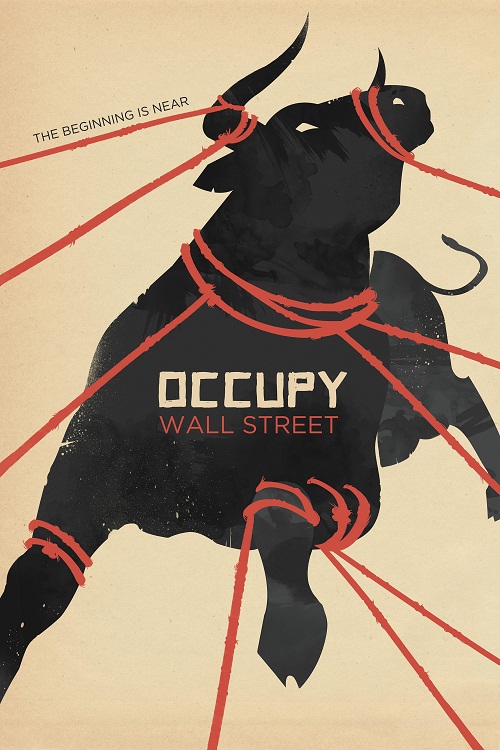
Alexandra Clotfelter."The Beginning is Near." Color offset lithograph on French paper, approximately 24 x 18 in. Edition of 160, 20 of which were included in the pre-publication sponsor’s edition “Occuprint 2012” (outside of the edition of 100). Image courtesy Booklyn Artists Alliance, Brooklyn.
The Occuprint Portfolio 2012 was a further distillation of the selection process, culled by Booklyn’s directing curator (and artist) Marshall Weber together with Goldstein in a series of meetings in early 2012. Weber states that it was important to them that the final group be “globally and topically representative of all of the works on Occuprint.org.” He also notes that a variety of historical art influences are present in the imagery, from Russian Constructivism to Latin American political graphic art to Pop. Chosen artists were asked to submit high-quality digital files that were translated to screenprint (one to letterpress) and printed at seven workshops throughout the country. Some of the final works are signed, others are not. The pre-publication sponsorship portfolios also included the aforementioned copy of the Occupied Wall Street Journal (no. 4), an offset print of Clotfelter’s image, and Tip of the Iceberg, a spraypainted stencil print by David Lowenstein. The images have appeared in a number of journals and blogs – a recent article in the July/August 2012 issue of Art in America included several images from the portfolio accompanied by statements from artists, curators, writers, and critics on the impact of the Occupy Movement, though the Occuprint images themselves were not discussed (Nato Thompson, “Debating Occupy,” Art in America 100, no. 6: 99-103).
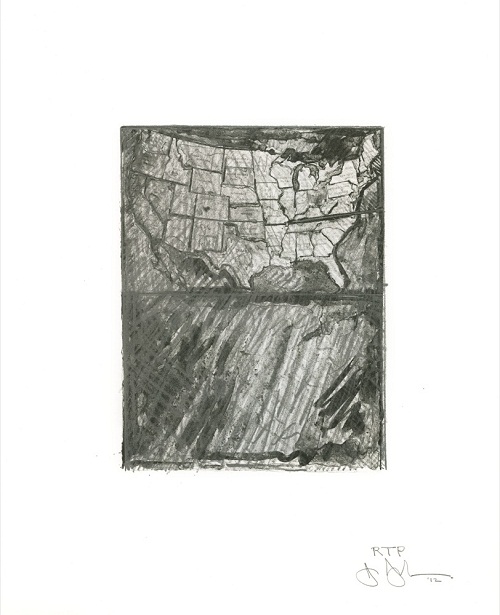
Jasper Johns. “Map,” from “Artists for Obama 2012.” Two-color lithograph, 14 x 11 1/2 in. Published by the Obama Victory Fund, Chicago, printed by Gemini G.E.L, Los Angeles, RTP outside of the edition of 150. Map © 2012 Jasper Johns and Gemini G.E.L. LLC.
Artists for Obama 2012, on the other hand, hearkens to a centuries-old tradition of political statements in printmaking by celebrated artists who employ their talents to raise awareness of causes or promote critical discussion and thought on issues. Such commentary is frequently oblique and general in nature, rather than specific. Jacques Callot’s two Miseries of War series (1632-33) are often cited as the first examples; later well-known works in this vein include Goya’s The Disasters of War (1810-20), Max Beckmann’s Hell portfolio (1919), and Andy Warhol’s Electric Chair imagery of the sixties and seventies. Group portfolios of work by established artists have also been used as a means to promote particular causes or events since the late 1960s, beginning with Artists and Writers Protest against the War in Vietnam (1967), and have become a popular means of raising funds for non-profit organizations. Likewise, the artists represented in Artists for Obama 2012 are among the most revered of our time, and the works reflect their individual responses to the current political climate. Content ranges from subtle to overt: some, such as Jasper Johns’s Map and Ed Ruscha’s We the People, imply larger issues at stake in this year’s election cycle, while others, such as Robert Gober’s Obama and Chris Burden’s Married, specifically reference Obama or his politics. The edition size of 150 reflects, in Joni Weyl’s words, the dual considerations of “how to maximize monies to the campaign [while] balancing the amount of time and effort to produce and deliver the portfolio.” Due to Gemini’s high printing standards, the wide range of media represented, and the number of impressions that are to be printed, production will require several months; supporters will receive the work in the spring of 2013.
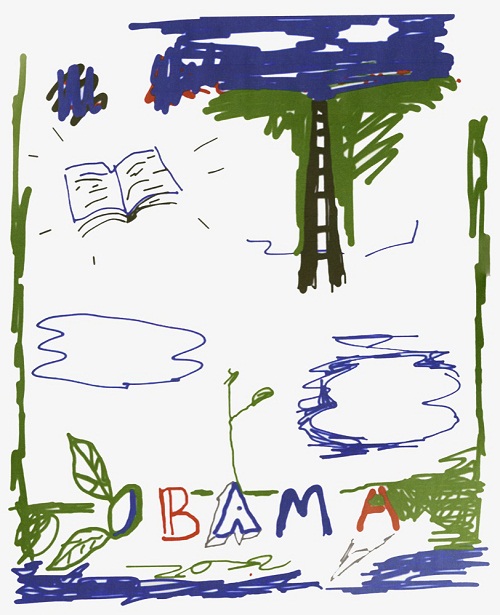
Robert Gober. “Obama,” from “Artists for Obama 2012.” Five-color screenprint, 14 x 12 in. Published by the Obama Victory Fund, Chicago, printed by Gemini G.E.L, Los Angeles, RTP outside of the edition of 150. Obama © 2012 Robert Gober and Gemini G.E.L. LLC.
In spite of such differences, these two portfolios share a left-leaning political vantage point. This is almost universally the case for political art, as this position is overwhelmingly favored by those in creative professions. As noted in the press release for the Artists for Obama 2012 portfolio, “Gemini G.E.L. and its artists have a lengthy history of creating editions to benefit national and Democratic causes.” Indeed, it is difficult if not impossible to find a counterpoint example produced by an organization on the right. Republican politicians have traditionally eschewed or even openly suppressed the arts (for instance, President Reagan attempted to abolish the National Endowment for the Arts in the early 1980s, and Senator Jesse Helms led a successful campaign to significantly weaken it later in the decade), so it is unsurprising that fine art publications have not been an avenue of fundraising for conservatives. As such, the scope presented by contemporary political prints is far from “fair and balanced,” but the fact that they can be openly published and promoted is certainly indicative of a healthy democratic society with full rights of free speech – a condition that would have been welcomed by Callot, Goya, and Beckmann, and one we should all fight to protect.




Pingback: Political Art for a Contentious Time | ARTT255
Pingback: New Class Project - Syd Webb
Pingback: Art Critique | soper15